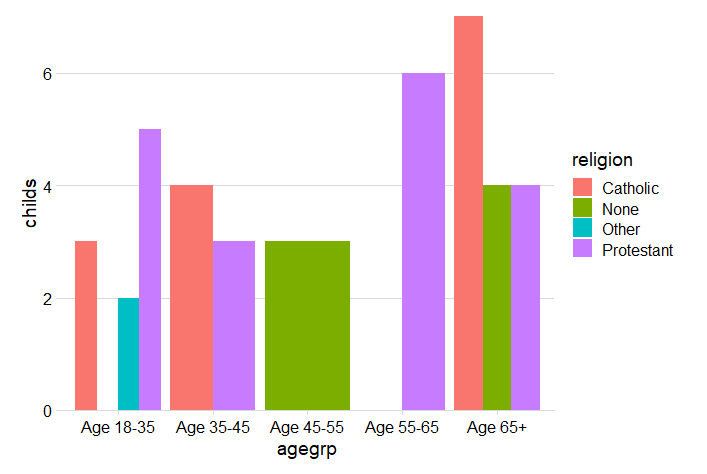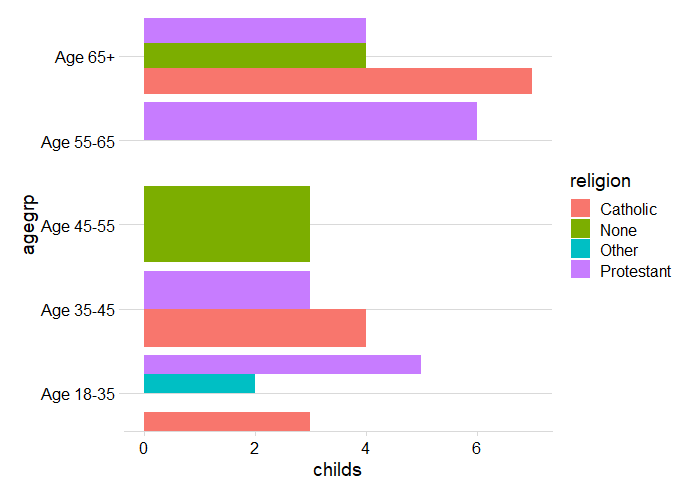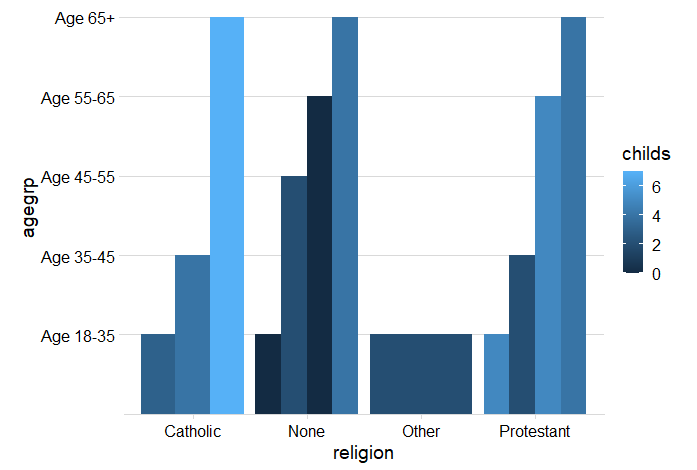I am trying to make a ggplot2 wrapper that adjusts the scale on the y-axis depending on the scale of y.
- plot_1: gives an error
- plot_2: with tidyeval, but the output has no
values on the y-axis - plot_3: this is how it should look
Any idea what causes this problem?
Maybe there is a different approach to this problem?
I hope the example helps to understand my problem. Thanks in advance!
# setup -------------------------------------------------------------------
library(ggplot2)
df <- data.frame(
childs = c(3, 0, 2, 4, 2, 2, 2, 3, 3, 4, 5, 4, 3, 5, 7, 2, 6, 5, 0, 2),
agegrp = as.factor(c("Age 45-55",
"Age 55-65","Age 65+","Age 35-45","Age 45-55","Age 45-55",
"Age 45-55","Age 18-35","Age 35-45","Age 65+",
"Age 18-35","Age 65+","Age 18-35","Age 55-65",
"Age 65+","Age 18-35","Age 55-65","Age 55-65",
"Age 18-35","Age 35-45")),
religion = as.factor(c("None","None",
"Catholic","Catholic","None","None","None","Catholic",
"Protestant","None","Protestant","Protestant",
"Catholic","Protestant","Catholic","Other",
"Protestant","Protestant","None","Protestant"))
)
# function ----------------------------------------------------------------
plot_1 <- function(data, x, y, fill) {
plot <-
ggplot(data = data,
mapping = aes(x = {{ x }}, y = {{ y }}, fill = {{ fill }})) +
geom_col(position = "dodge")
if (is.numeric(y)) {
scale <-
scale_y_continuous(expand = expansion(mult = c(0, 0.05)),
breaks = scales::breaks_extended(),
labels = scales::label_number(big.mark = "'"))
} else {
scale <-
scale_y_discrete(expand = expansion(mult = c(0, 0.05)),
breaks = scales::breaks_extended(),
labels = scales::label_number(big.mark = "'"))
}
plot +
scale +
cowplot::theme_minimal_hgrid()
}
plot_2 <- function(data, x, y, fill) {
plot <-
ggplot(data = data,
mapping = aes(x = {{ x }}, y = {{ y }}, fill = {{ fill }})) +
geom_col(position = "dodge")
cond <- enquo(y) # tidyeval
if (is.numeric(cond)) {
scale <-
scale_y_continuous(expand = expansion(mult = c(0, 0.05)),
breaks = scales::breaks_extended(),
labels = scales::label_number(big.mark = "'"))
} else {
scale <-
scale_y_discrete(expand = expansion(mult = c(0, 0.05)),
breaks = scales::breaks_extended(),
labels = scales::label_number(big.mark = "'"))
}
plot +
scale +
cowplot::theme_minimal_hgrid()
}
plot_3 <- function(data, x, y, fill) {
plot <-
ggplot(data = data,
mapping = aes(x = {{ x }}, y = {{ y }}, fill = {{ fill }})) +
geom_col(position = "dodge")
plot +
cowplot::theme_minimal_hgrid()
}
# test --------------------------------------------------------------------
plot_1(df, agegrp, childs, religion)
#> Error in plot_1(df, agegrp, childs, religion): object 'childs' not found
plot_2(df, agegrp, childs, religion)

plot_3(df, agegrp, childs, religion)

Created on 2022-10-14 by the reprex package (v2.0.1)


